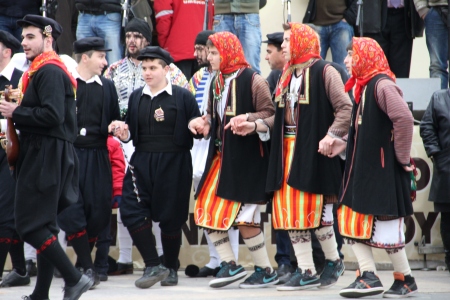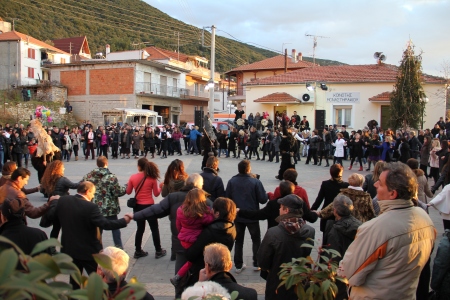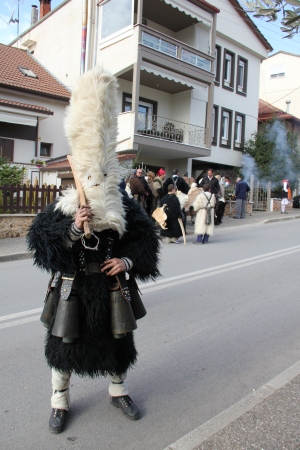
The twelve days between Christmas and the New Year are still held to be holy days in Greece, a mystical and dangerous time when mischievous spirits emerge from the underworld, seeking to wreak havoc in the human realm. On the 6th of January, Theophania or Twelfth Night, masked men in goatskins and sheepbells dance through the streets to dispel these spirits, awaken the fertility of the earth, and ensure a good year. The name Theophania, literally ‘the appearance of god’, here refers to the return of the sun after the winter solstice, and fire and light are very important to this holiday.
The rituals I describe here come from six tiny villages in the region of Drama, just south of the Rhodope Mountains, close to the border between northern Greece and Bulgaria. Similar rituals featuring masked, bell-wearing men appear all through the Balkans and Central Europe as far as the Swiss Alps. They will dance through the village streets, in the cemetery, and in front of every house, in a ritual of blessing and catharsis which has roots in age-old worship of Dionysus, god of fertility and wine.
For me, who came to Greece to study women’s traditional songs, dances and costumes, it makes a refreshing change to observe ritual customs almost exclusively performed by men. These activities take place in winter, either at Theophania or during Carnival, in contrast to spring and summer rituals which are chiefly in the hands of the women. However, as we shall see, in order for men to assume ritual abilities and responsibilities normally ascribed to women, some of the men must dress in women’s clothes.
Here I would like to mention Carol Christ’s recent analysis of essentialism in feminist theory in her excellent post of September 15. In Carol’s words, the essentialist view holds that the “‘essential qualities’ of a thing (a table, a horse, a woman, or a man) precede the ‘existence’ of any individual in the group to which it belongs; these qualities are universally—always and everywhere—expressed by members of the group.”
Carol and I both live in Greece, where, as in many other parts of the world, tradition assigns quite different tasks and attributes to men and to women. Without reawakening the essentialist discussion here, I would just like to say that modern-day feminists do not have to agree on whether women and men are essentially or inevitably different; however, in order to understand Balkan culture, we do need to realise that people here believe in these differences and have done since ancient times.

Back in Drama, in the village of Monastiraki, preparations have been underway for days. The night before the big event, a designated house – half-ruined, but still with a roof intact – slowly fills with the joy of friends and acquaintances greeting one another. Red wine flows, and traditional goat soup is served free to all. A fire has been kept burning here continuously throughout the twelve nights of Christmas, producing sacred ash with healing and protective powers. Musicians play through the night, producing archaic sounds on the Macedonian bowed lyra or kemene, accompanied by large goatskin tambourines called daheres. These are the only instruments. The overall effect is all the more hypnotic as the musicians play in absolute unison; even the singing is monophonic, in a musical structure intended to emphasise old values of community and coherence.
Meanwhile, people dance the same few dances over and over. As on all ritual occasions, the repetition of familiar simple step patterns frees the dancers to focus on the inner work of igniting their own good mood and raising good energy (kefi) to bless the community.
After dancing and drinking all night, the male celebrants help each other dress in the early hours of dawn. They are truly fearsome in shaggy dark skins, tall conical masks, and wide leather belts from which swing three pairs of heavy double bells. One of their names, koudonofori, means bell wearers; they are also called Arapides, the Black Ones or Moors.
Looking behind the apparent racism of the terminology, these ritual dancers blacken their skin with burnt cork both to invoke the power and protection of the sacred fire, and also in order to enter the realm of darkness. Here, the dark is seen as the repository of the earth’s fertile powers, which their bells and dances aim to awaken, as well as the realm of things ‘not seen’ , such as the spirits known as kallikantzari, which pose a threat to the new light and the new year. They themselves must go unseen, in masks and disguises, to enter this realm.

Brandishing long wooden swords, this group – known as a tseta – appears fully capable of driving out any number of kallikantzari. The phallic swords and headdresses leave one in no doubt that the Theophania rituals are men’s rituals, yet the ability to give new life, to enter the realms of the dead, and to bestow the blessing of fertility are essentially women’s powers. To claim these powers, some of the men must dress as women, as Dionysian revellers have done since ancient times. These are theGilinges, or Brides.

Wearing women’s clothing may be a means for men to temporarily gain access to the realms of life and death, where normally only women may go, or to symbolically give birth to the life-affirming fertility and joy which bring renewal at this dark and hungry time of the year. (Men wearing women’s clothing for ritual purposes are depicted in archaeological finds dating back to the 5th C. BCE; I think we see it today in the ecclesiastical robes worn by Christian priests.) In an additional affirmation of what is seen as women’s power, the Brides’ costume is rich in goddess embroideries, while all the members of the party wear beaded amulets in the lozenge-shaped symbol of female fertility going back to Neolithic times. Goddess symbols are also stamped on many of the bells.
As well as the Arapides and the Brides, the tseta includes Pappoudes or Grandfathers in Thracian men’s traditional dress, and Evzones or Tsoliades wearing short white pleated foustanella kilts and thetsevres, a special garment made of twelve large white kerchiefs sewn into a triangle densely fringed with beads, sequins and coloured threads, which takes four months to prepare.

There is also an occasionally appearing Bear, who some say represents ancient worship of the Goddess Artemis.
As they journey together through the village, the bell-wearers leap and stamp, swinging their bells back and forth in an apotropaic din – this will indeed awaken the earth! – almost drowning out the eerie sound of the lyras and daïres. The Evzones dance with athletic half-turns which send their short kilts sailing up to their waist, emphasising (so I am assured) the fertile power of the male generative organs, without revealing the organs themselves. At every house the entire tseta is rewarded with abundant food and drink, in the living tradition of sacred hospitality which is the most powerful blessing of all.

By three o’clock, the whole village gathers at the plateia to dance. Hundreds of people spiral into a single circle with one leader, keeping the large centre open as a sacred space for the tseta to enact ancient rituals of death and resurrection, plowing and planting, and the hieros gamos or sacred wedding. The dancing goes on until dusk and then continues at a taverna through a second consecutive night.

Each village has its own variation of the Theophania rituals. In some places, children and women also participate: in Ksiropotamos young girls dance in traditional costume, while in Petrousa, all the dahereplayers are teenage girls. Some traditionalists view this change with unease, but I must confess my pleasure at seeing thirteen young women lined up like priestesses of Cybele from the time when the drummers were women. Here too, people dance at crossroads, springs, sacred trees and finally around an enormous bonfire.

Fire is important in all the Theophania rituals, and cauldrons on open fires are a key part of the festivities. This is another symbol of women’s power adopted on this occasion by men – traditionally, women cooked in pots; men roasted meat over an open fire. In Petrousa, the Dance of the Cooks can still be seen. Although it is no longer danced around the cauldrons themselves, the symmetrical step pattern still focuses the energy or ‘fire’ of the dancers in a particular way.
It seems to me that these fire-focused rituals hint at the unnamed presence of the Goddess Hestia, whose domain is centred on the hearth, source of light, warmth, food and all that is beneficial to the home. The nikokira, the lady of the house, was seen since ancient times as Hestia’s priestess. Her role is to tend the sacred fire through practical and ritual work and to literally focus its brilliance (estiazo, fromHestia, means ‘to focus’) so that it may bless the household and all its inhabitants. In ritual activities such as the Theophania, through the mediation of men dressed as women, this focused fire can be brought once a year from the private space of the home – the realm of the women – into the public space of the village, the realm of the men. This union of men’s and women’s fertile powers is the hieros gamos, the holy spark of blessing which ensures health, wealth, happiness and abundance for all in the coming year.

Photos by Lenka Harmon, Spyros Taramigos, and Laura Shannon
Laura Shannon has been researching and teaching traditional women’s ritual dances since 1987. She is considered one of the ‘grandmothers’ of the worldwide Sacred / Circle Dance movement and gives workshops regularly in over twenty countries worldwide. Laura holds an honours degree in Intercultural Studies (1986) and a diploma in Dance Movement Therapy (1990). She has also dedicated much time to primary research in Balkan and Greek villages, learning songs, dances, rituals and textile patterns which have been passed down for many generations, and which embody an age-old worldview of sustainability, community, and reverence for the earth. Laura’s essay ‘Women’s Ritual Dances: An Ancient Source of Healing in Our Times’, was published in Dancing on the Earth.


I would love to see these rituals.
Here in Lesbos men in some of the other villages men wear bells and skins at Carnival time. In my village men dress up as women for Carnival. In the cases of men dressing as women I have seen, I have felt uneasy, as I wonder if this is just another “mask” of patriarchal domination and control. I feel differently when less frequently women dress up as men. In one case the more powerful are mocking the less powerful; in the other the powerless are wearing the clothes of the powerful. Or so it seems to me.
You state that in the rituals you describe, men are stealing women’s ritual power. Is this act “just for fun” which might be OK, or is it one step along the way to the priesthood and patriarchate of the Greek Orthodox Church, where men wearing skirts have all the officially recognized power? Another thought, do the priests and patriarchs wear beards to suggest that despite their skirts, the power they have derives from maleness and never was stolen in the first place?
I must add that I feel profoundly disturbed by the word αραπης which has some of the connotations of the “n” word. I don’t think we can just “pass over” the fact that the word “seems” racist. It is racist, no matter what the origins of the ritual are.
LikeLike
Yes, I agree that the word ‘arapis’ is disturbing. I wish I knew more about the origins of this particular custom – specifically, whether the character in the ritual drama predates the word connoting the character, which might indicate a non-offensive origin for the role, despite the offensive name in current use. Similar customs in other parts of Greece and the Balkans, both at Theophania and Carnival, frequently include a dark-skinned character, but I do not know what names are used for him. There are archaeological portrayals of men dancing in women’s clothing for ritual purposes as early as the Classical period, but again, I don’t know at what point the ‘Arab’ character became part of these customs.
Certainly Theophania and Carnival are times of engaging with the energy seen as ‘other’ and therefore to be feared, as you say, which is often given form through terrifying masks and disguises. Perhaps it is worth noting that Carnival customs (which have much in common with Theophania rituals since they are usually carried out by the same groups of men in the villages) are times of taboo-breaking, where a lot of shocking language is used in the songs, specifically words otherwise not acceptable in polite society. The people I know who carry on the ritual customs in Drama are proud to call themselves ‘Arapides’ in the context of their rituals, but would not use the word ‘arapis’ to denigrate a person of colour.
I wonder if we will be able to pressure Greeks to rename the Arapides (the way the Dutch are beginning to do with their racist Christmas character Black Peter, for example), or do you feel the character itself is racist no matter what terminology they use?
LikeLike
PS About the ‘men stealing women’s ritual power’, I think in this instance they are borrowing it, not taking it away from the women (though patriarchy certainly does plenty of that in other contexts). Women have responsibility for most of the spring and summer rituals in the Balkans, as well as all the rituals around birth and death, so one way of looking at the men’s ritual activities at Theophania and Carnival is that it gives the women a chance to take a little time off.
About men wearing skirts in positions of officially recognised power: I am writing this from southern Morocco, where men wearing jellabas are a reminder that long caftan-like robes have been a male garment in the Near East & North Africa since ancient times…
LikeLike
I looked up αραπης online and found it translated by the “n” word by google, while syntrans and bing refused to translate it. Two of my dictionaries translated it as negro, dark-skinned, or bogey. One translated it simply as negro. The term categorizes the darker-skinned person as “the other” and as to be feared.
LikeLike
Thanks, Laura, for your fascinating posts regarding the history of dance and modern festival traditions in Greece. The photos too are so interesting!!!
I remember reading somewhere that the lesser women’s festivals in ancient Greece occasionally allowed men to join in, not only by dressing up, but by giving them women’s names, that is, for the time of their participation.
LikeLike
Thanks for this great article and pictures, too.
Wish we could have a troupe of these dancers in the streets of Paris. SIGH.
LikeLike
Fascinating! I remember the first time I saw the Gaden Shartze (I may have misspelled this) monks from Tibet. They dressed as women for their sacred dances. After the dancing, I went up to one who spoke English. “Where are the nuns?” I asked him. “They’re at home. Doing the housekeeping,” he said.
There’s a long history, of course, of men dressing as women, not just the old men in skirts in churches (from the pope on down), but also in drama. We all know that Shakespeare’s female characters were played by male actors because women weren’t allowed on the stage. The Puritans kept trying to close down the theaters, and women on stage would have driven them into even fiercer warfare against any kind of entertainment. In Shakespeare’s Twelfth Night, of course, a boy actor plays a girl playing a boy. I once saw an awful production in which all the characters engaged in belly dancing–because, the director said, the play is set in a land near Greece!–before the opening scene.
Do people just like to find any excuse to dress up? To sometimes cross dress?
LikeLike
How interesting about the monks dressed as women for sacred dances. I would suspect that the nuns do their own private rituals when the monks are not around. I have seen many women’s ritual customs in Greece which men are not permitted to see and therefore do not even know about.
I agree with Carol that men’s and women’s cross-dressing have different purposes and qualities, which further differ according to the occasion. At Carnival, people do it it for fun as well as in keeping with the ancient ritual customs; the cross-dressing aspect is comic, lewd, and can be mocking, as Carol points out – which is not at all the attitude with which the ‘Brides’ in Drama wear women’s costume at Theophania.
LikeLike
Fascinating post and perspective. Glad to see there is still plenty of drama in Drama!
LikeLike
What a delightful post–I appreciate it in particular because I have never been to Greece. Love the pictures.
LikeLike
Thanks, Laura. Your posts are fascinating. They make me want to go back to folk dancing.
LikeLike
Laura, what I really appreciate about your article is how you draw connections between current traditions and ancient worship of the Goddess. Thank you for bringing such depth.
LikeLike